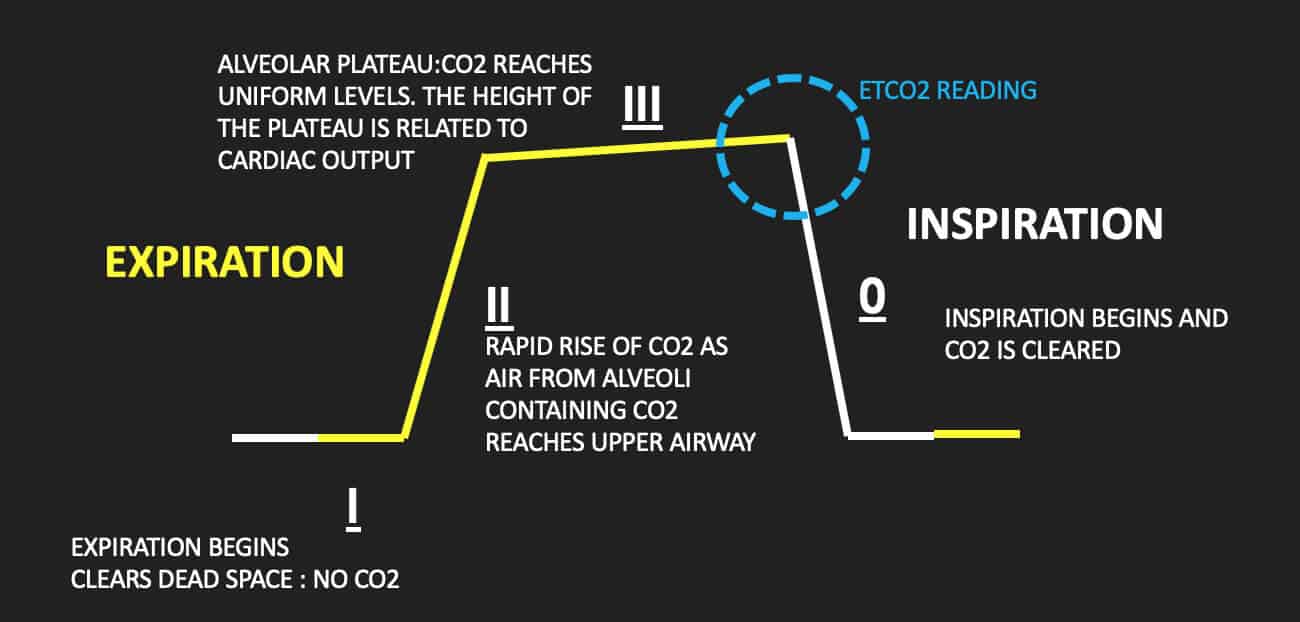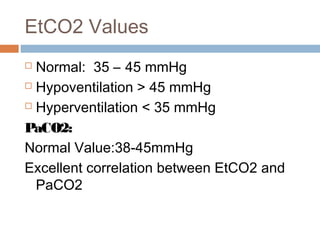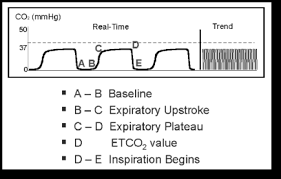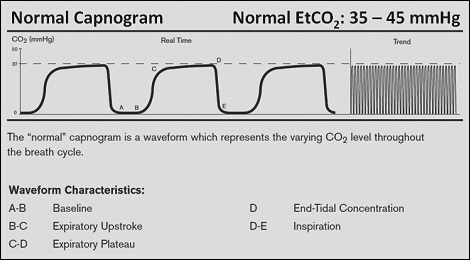end tidal co2 range
In infants and children breathing spontaneously the PETCO 2 values range from 36-40 mmHg9 Normally PETCO 2. A low end-tidal CO2 may indicate poor perfusion hypovolemia or sepsis.

Waveform Capnography In The Intubated Patient Emcrit Project
The height of the capnography waveform accompanies this number on the monitor as well as the respiratory rate.

. Although the normal range for CO2 should be between 35-45mmHg CO2 monitoring gives healthcare providers a lot more insight into what is going on with a patients condition. On the other hand a high CO2 reading may indicate airway narrowing. However EtCO2 is an extremely powerful surrogate for endotracheal tube ETT P osition CPR Q uality R eturn of spontaneous.
End tidal Co2 ranges vary slightly from actual PaCo2 and can be affected by many factors depending on the condition of the patients lungs. Literature search was performed using Medline and EMBASE. Theoretically you could have a very disturbed total body perfusion and ventilation peri-arrest near-apnea with a relatively normal-looking EtCO 2 value.
Available evidence has established that ETCO2 measurement can provide an indication of cardiac output and pulmonary blood flow24 Non. End-Tidal CO2 in Cardiopulmonary Resuscitation. The number is called capnometry which is the partial pressure of CO 2 detected at the end of exhalation ranging between 35 - 45 mm Hg or 40 57 kPa.
We aimed to determine the value of sidestream end-tidal carbon dioxide SS-ETCO2 measurement in patients with chronic obstructive pulmonary disease COPD in the emergency department. Understanding End Tidal CO 2 Monitoring. Find content updated daily for end tidal co2.
Waveform capnography should be monitored in all intubated patients and displayed on the monitor as above. When CO2 diffuses out of the lungs into the exhaled air a device called a. In severe cases of respiratory distress increased effort.
Ad Looking for end tidal co2. Animals that are breathing spontaneously should have an end-tidal carbon dioxide concentration in the range of 46. The gradient is the difference between the arterial carbon dioxide partial pressure PaCO 2 and the etCO 2 partial pressure is a result of the relationship between ventilation and perfusion or rather ventilation-perfusion matching VQ.
Two cases of malignant hyperthermia are described where the earliest sign was a rise in the end-tidal CO2 concentration. ETCO2 levels reflect the adequacy with which carbon dioxide CO2 is carried in the blood back to the lungs and exhaled. 39 Treveno RP Bisera J Weil MH Rackow EC Grundler WG.
End-tidal capnography or end-tidal CO2 EtCO2 monitoring is a non-invasive technique that measures the partial pressure or maximal concentration of carbon dioxide CO2 at the end of an exhaled breath. The purpose of this systematic review is to evaluate the prognostic value of ETCO2 during cardiac arrest and to explore whether ETCO2 values could be utilised as a tool to predict the outcome of resuscitation. A-B The baseline that is the level of minimum CO2 concentration observed immediately after inspiration.
Cross-sectional associations between ETCO2 and PaCO2 were examined in the study. An accurate early predictor of the outcome of resuscitation is needed. End-tidal CO2 is the concentration of ETCO2 capnographic measured at the end of tidal volume expired Point D in the above diagram.
End-tidal carbon dioxide ETCO2 is the level of carbon dioxide that is released at the end of an exhaled breath. EtCO2 is a measurement of the partial pressure of CO2 in gas expired at the end of exhalation when exhaled gas will most closely resemble the alveolar CO2 concentration. End Tidal CO 2 sampling Ventilatory function minute ventilation decreases and therefore CO2 increases in a A dead space gasno CO2 B mixed.
The amount of CO2 at the end of exhalation or end-tidal CO2 ETCO2 is normally 35-45 mm HG. N Engl J Med 1988318607-11. End tidal CO 2 monitoring is represented as a number and a graph on a monitor.
End-tidal CO2 EtCO2 monitoring is a measure of metabolism perfusion and ventilation. For a person with normal lungs the difference between end tidal and Paco2 can vary between 5-8mmHg depending on the book your reading. More Than Just a Number.
In the ED we typically think of a EtCO2 as a marker of perfusion and ventilation. When calculating the gradient the clinician is comparing the carbon dioxide CO 2 sampled from the ABG. What is end-tidal CO2 etCO2.
The normal values are 5-6 CO2 which is equivalent to 35-45 mmHg. Hypocapnia hypotension and hypertension during aneurysm occlusion in patients with an aneurysmal subarachnoid hemorrhage may lead to a poor prognosis but evidence for end-tidal carbon dioxide ET co 2 and mean arterial pressure MAP targets is lackingWithin the ranges of standardized treatment the authors aimed to study the association between hypocapnia Pa. So the short answer is you are right about the ranges 35-45 but that.
End-tidal CO2 as a guide to successful cardiopulmonary. End-tidal carbon dioxide concentration during cardiopulmonary resuscitation. 35-45 mm HG The amount of CO2 at the end of exhalation or end-tidal CO2 ETCO2 is normally 35-45 mm HG.
This prospective cross-sectional study has been carried out over a 3-month. At the end of expiration gas sampled from the trachea should be alveolar gas and the CO 2 level will equate to the alveolar and therefore arterial CO2 in dogs and cats that dont have lung disease. What is the normal range for end tidal CO2 as measured by capnography.
For example a perfusion deficit may lower EtCO 2 while a ventilation deficit may raise it. The end-tidal CO2 value is not pathology-specific or diagnostic. The waveform is called capnograph and shows how much CO 2 is present.

Waveform Capnography In The Intubated Patient Emcrit Project

Average Etco2 Kpa During Cpr In Patients With Or Without Rosc Download Scientific Diagram

End Tidal Carbon Dioxide Recording Of Ventilated Children In Picu N 535 Download Scientific Diagram

Exhaled Carbon Monoxide End Tidal Co2 And Peripheral Oxygen Saturation Download Table

Capnography Provides Bigger Physiological Picture To Maximize Patient Care Jems Ems Emergency Medical Services Training Paramedic Emt News

Basic Waveform Capnography As A Continuous Monitoring Tool During Mechanical Ventilation

Exhaled Carbon Monoxide End Tidal Co2 And Peripheral Oxygen Saturation Download Table

Waveform Capnography In The Intubated Patient Emcrit Project

The Impact Of Ventilation Rate On End Tidal Carbon Dioxide Level During Manual Cardiopulmonary Resuscitation Resuscitation
Emdocs Net Emergency Medicine Educationcapnography In The Ed Emdocs Net Emergency Medicine Education
End Tidal Co2 Monitoring In The Pre Hospital Environment More Than Just Endotracheal Tube Placement Confirmation Journal Of Paramedic Practice

Etco2 In Non Intubated Patient A Must In Ed
Riding The Wave Of Capnography Understanding Etco2 Vetbloom Blog

Waveform Capnography In The Intubated Patient Emcrit Project


